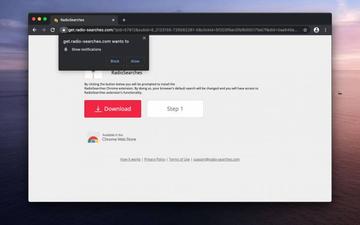This article is tailor-made for removing onclickbright.com virus from Mac so that its malvertising through browser redirects and popups comes to a halt.
No matter how frustrating it sounds, computers with macOS onboard are being shelled with petty, yet hugely noxious threats collectively referred to as adware. Those who find this phrase far-fetched and still unconditionally trust in the long-standing mantra about the opposite should take a look at the Onclickbright threat. It hinges on a prolific strain of adware that sneaks into a Mac through a minimum of user involvement and takes over the default settings in Safari, Google Chrome, and Mozilla Firefox. The upshot of these shenanigans is that the prerogative of deciding which websites to visit suddenly slips out of the victim’s control. The affected browser starts redirecting the web traffic to onclickbright.com/jump/next.php URL concatenated by a string denoting the campaign ID, which is a shady counterpart of a garden-variety affiliate identifier.
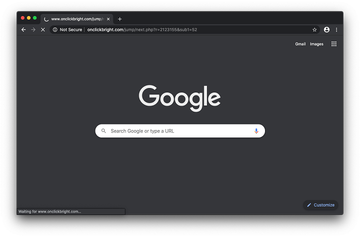
The rerouting often takes place spontaneously, at least that’s what it looks like to the naked eye. Here’s a common scenario: when on a news site or a social network, a user gets rerouted to onclickbright.com out of the blue after randomly clicking something. However, there are distinct prerequisites underlying this ostensibly unsystematic drag. In addition to skewing custom settings such as the homepage and default search engine, the potentially unwanted application (PUA) that has previously infiltrated the Mac can invoke scripts that do the evil magic amid a web surfing session. Therefore, the annoying scheme is multi-pronged as it relies on both specific triggers, for instance the victim’s web search attempt, and on inconspicuous execution of dodgy scripts.
Onclickbright may re-infect your Mac multiple times unless you delete all of its fragments, including hidden ones. Therefore, it is recommended to download Combo Cleaner and scan your system for these stubborn files. This way, you may reduce the cleanup time from hours to minutes.
Download Now Learn how Combo Cleaner works. If the utility spots malicious code, you will need to buy a license to get rid of it.What’s the whole point of this foul play? For a security-aware person, it’s as clear as day. Onclickbright is a conduit for what’s called malvertising. This is an unethical way of promoting web services and applications through intrusive techniques. In other words, the browser hijacker is intended to dupe Mac users into opting for a solution they don’t need. When redirected via onclickbright.com/jump/next.php, the browser resolves a merry-go-round of ad network domains and ultimately lands on a fishy download recommendation page. These resulting sites can vary each time the forwarding occurs. For instance, it can be a page pushing the RadioSearches extension, a browser hijacker that has no information lookup power of its own – instead, it reroutes all queries to Yahoo.
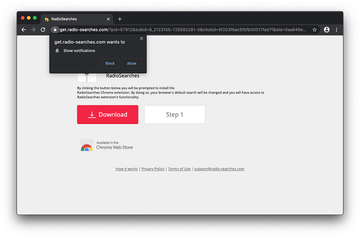
In this case, the aggressive promo site displays a popup request to show notifications. This adds yet another layer to the brainwashing, because if granted, the privilege allows the add-on to trigger numerous web push notifications even outside the browser. A yet more intricate landing page bolstered by Onclickbright Mac virus is one that recommends installing a booby-trapped Adobe Flash Player update (see screen capture below). It’s parked at s3.amazonaws.com. The drive-by download is a ZIP file that supposedly contains the update. However, the installer combines the legitimate product with one or several extras such as scareware, adware, or a banking Trojan. The Flash Player related hoax is notoriously prevalent in the Mac malware distribution area.
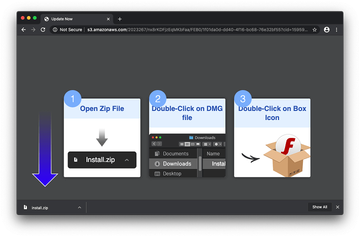
As a matter of fact, there are many more PUAs whose propagation is fueled by Onclickbright hijacker. They run the gamut from irksome browser toolbars to malicious bundles that install different types of Mac viruses without the user’s awareness. Several other examples of the apps relying on this distribution cradle are as follows:
- FunSafeTab;
- Media-Tab;
- SocialNewPages;
- TVPlusNewTab;
- NewTabTV;
- ConverterzSearch;
- SportsHDSearchs;
- TiktokSearches;
- StreamsSearch;
- TechSignalSearch
On numerous occasions, onclickbright.com will be bringing the victim to a site that doesn’t endorse any software but pulls off the above-mentioned web push notifications hoax instead. Its URL is pushwelcome.com. It may cloak its tricky requests underneath a human verification checkbox which, once ticked, automatically gives the unwanted service the permissions it wants. This single click becomes a springboard for a deluge of popup ads on the Mac.
While the Onclickbright virus often sets sketchy bundles in motion, it mainly infects Macs in the exact same way itself. Therefore, it’s always a good idea to explore the deep structure of a software package before agreeing to the bulk setup. As soon as the pest is inside, it changes the Internet browsing preferences and establishes persistence by adding a Login Item and possibly also a new configuration profile. These quirks should be taken into consideration as far as Onclickbright removal goes. The paragraphs below will explain how to iron this infection out of a Mac for good.
Onclickbright virus manual removal for Mac
The steps listed below will walk you through the removal of this malicious application. Be sure to follow the instructions in the specified order.
Expand the Go menu in your Mac’s Finder bar and select Utilities as shown below.
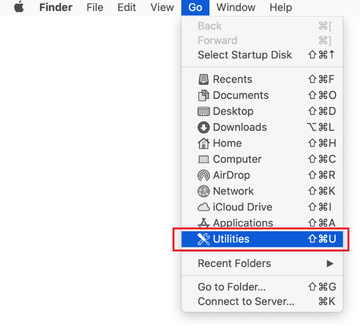
Locate the Activity Monitor icon on the Utilities screen and double-click on it.
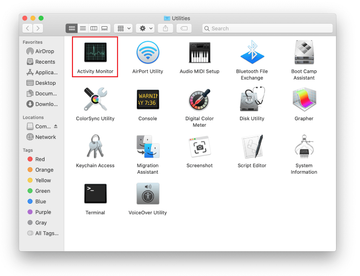
In the Activity Monitor app, look for a process that appears suspicious. To narrow down your search, focus on unfamiliar resource-intensive entries on the list. Keep in mind that its name isn’t necessarily related to the way the threat is manifesting itself, so you’ll need to trust your own judgement. If you pinpoint the culprit, select it and click on the Stop icon in the upper left-hand corner of the screen.
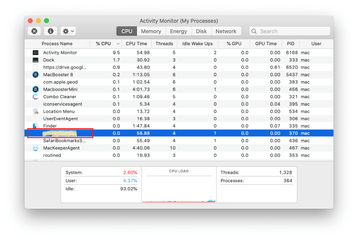
When a follow-up dialog pops up asking if you are sure you want to quit the troublemaking process, select the Force Quit option.
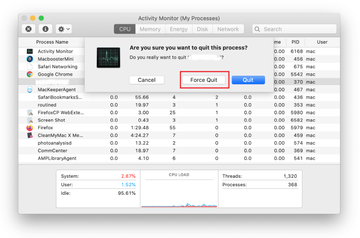
Click on the Go menu icon in the Finder again and select Go to Folder. You can as well use the Command-Shift-G keyboard shortcut.
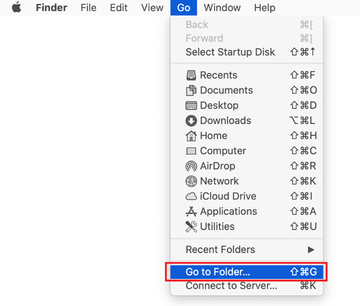
Type /Library/LaunchAgents in the folder search dialog and click on the Go button.

Examine the contents of the LaunchAgents folder for dubious-looking items. Be advised that the names of files spawned by malware may give no clear clues that they are malicious, so you should look for recently added entities that appear to deviate from the norm.
As an illustration, here are several examples of LaunchAgents related to mainstream Mac infections: com.pcv.hlpramc.plist, com.updater.mcy.plist, com.avickUpd.plist, and com.msp.agent.plist. If you spot files that don’t belong on the list, go ahead and drag them to the Trash.
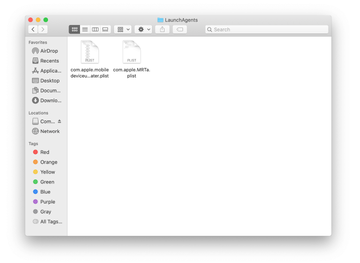
Use the Go to Folder lookup feature again to navigate to the folder named ~/Library/Application Support (note the tilde symbol prepended to the path).
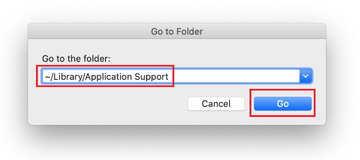
When the Application Support directory is opened, identify recently generated suspicious folders in it and send them to the Trash. A quick tip is to look for items whose names have nothing to do with Apple products or apps you knowingly installed. A few examples of known-malicious folder names are Quick Mac Booster, IdeaShared, and ProgressMatch.
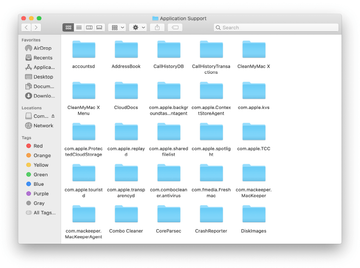
Enter ~/Library/LaunchAgents string (don’t forget to include the tilde character) in the Go to Folder search area.
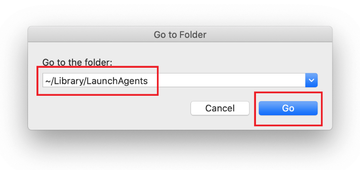
The system will display LaunchAgents residing in the current user’s Home directory. Look for dodgy items related to Onclickbright virus (see logic highlighted in subsections above) and drag the suspects to the Trash.
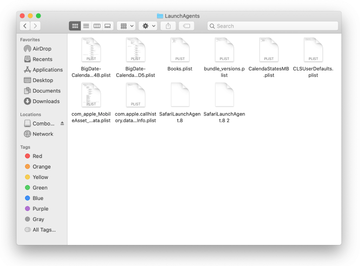
Type /Library/LaunchDaemons in the Go to Folder search field.

In the LaunchDaemons path, try to pinpoint the files the malware is using for persistence. Several examples of such items cropped by Mac infections are com.pplauncher.plist, com.startup.plist, and com.ExpertModuleSearchDaemon.plist. Delete the sketchy files immediately.
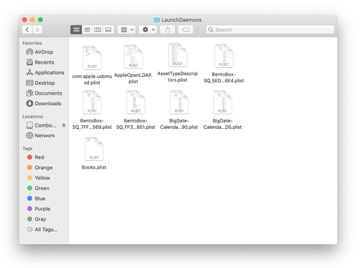
Click on the Go menu icon in your Mac’s Finder and select Applications on the list.
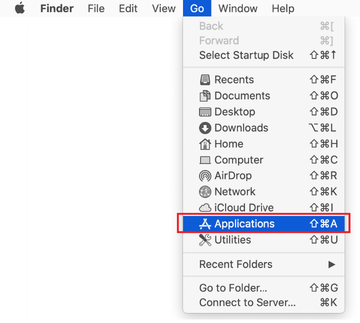
Find the entry for an app that clearly doesn’t belong there and move it to the Trash. If this action requires your admin password for confirmation, go ahead and enter it.
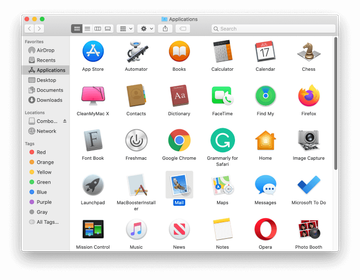
Expand the Apple menu and select System Preferences.
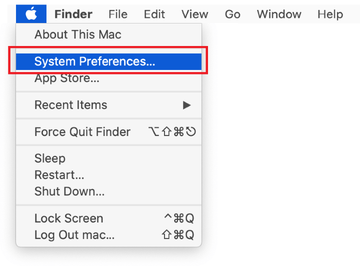
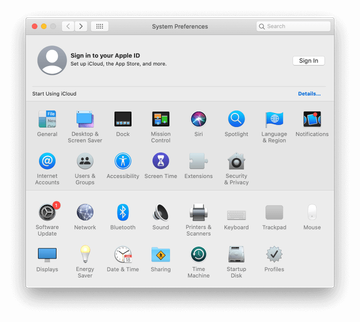
Proceed to Users & Groups and click on the Login Items tab.
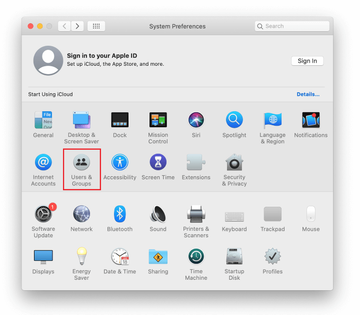
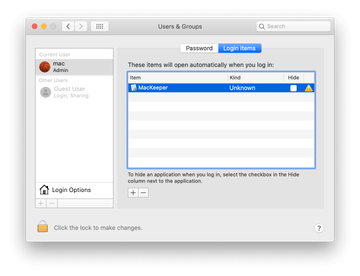
Now select Profiles under System Preferences. Look for a malicious item in the left-hand sidebar. Several examples of configuration profiles created by Mac adware include TechSignalSearch, MainSearchPlatform, AdminPrefs, and Chrome Settings. Select the offending entity and click on the minus sign at the bottom to eliminate it.
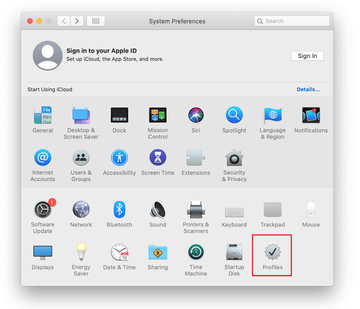
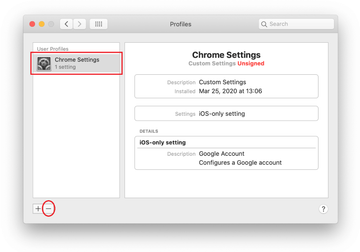
Get rid of onclickbright.com redirects and popups in web browser on Mac
To begin with, the web browser settings taken over by the Onclickbright virus should be restored to their default values. Although this will clear most of your customizations, web surfing history, and all temporary data stored by websites, the malicious interference should be terminated likewise. The overview of the steps for completing this procedure is as follows:
- Remove Onclickbright virus in Safari
- Open the browser and go to Safari menu. Select Preferences in the drop-down list
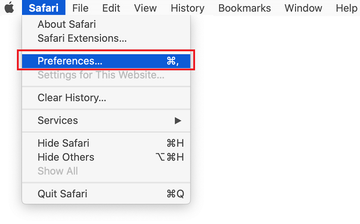
- Once the Preferences screen appears, click on the Advanced tab and enable the option saying “Show Develop menu in menu bar”.
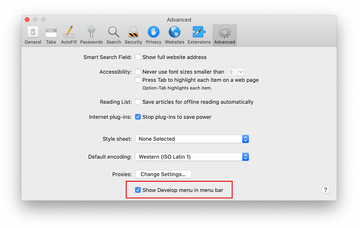
- Now that the Develop entry has been added to the Safari menu, expand it and click on Empty Caches.
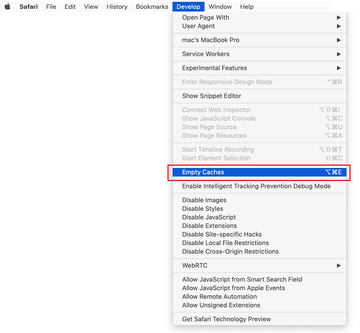
- Now select History in the Safari menu and click on Clear History in the drop-down list.
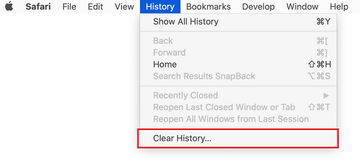
- Safari will display a dialog asking you to specify the period of time this action will apply to. Select all history to ensure a maximum effect. Click on the Clear History button to confirm and exit.
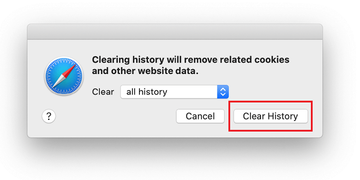
- Go back to the Safari Preferences and hit the Privacy tab at the top. Find the option that says Manage Website Data and click on it.

- The browser will display a follow-up screen listing the websites that have stored data about your Internet activities. This dialog additionally includes a brief description of what the removal does: you may be logged out of some services and encounter other changes of website behavior after the procedure. If you’re okay with that, go ahead and click on the Remove All button.
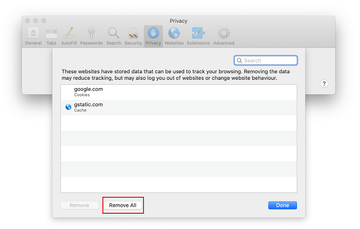
- Restart Safari
- Open the browser and go to Safari menu. Select Preferences in the drop-down list
- Get rid of onclickbright.com virus in Google Chrome
- Open Chrome, click the Customize and control Google Chrome (⁝) icon in the top right-hand part of the window, and select Settings in the drop-down
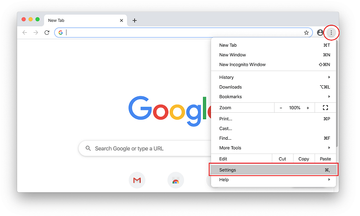
- When on the Settings pane, select Advanced
- Scroll down to the Reset settings section.
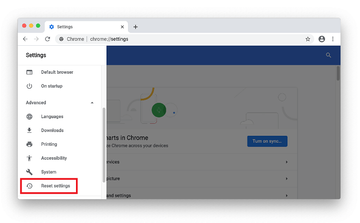
- Confirm the Chrome reset on a dialog that will pop up. When the procedure is completed, relaunch the browser and check it for malware activity.
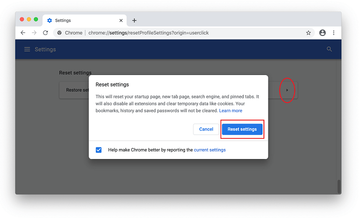
- Open Chrome, click the Customize and control Google Chrome (⁝) icon in the top right-hand part of the window, and select Settings in the drop-down
- Remove Onclickbright from Mozilla Firefox
- Open Firefox and go to Help – Troubleshooting Information (or type about:support in the URL bar and press Enter).
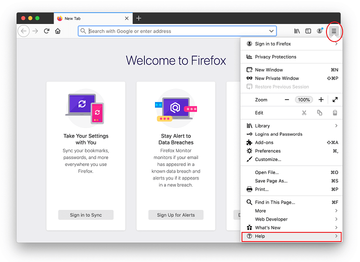
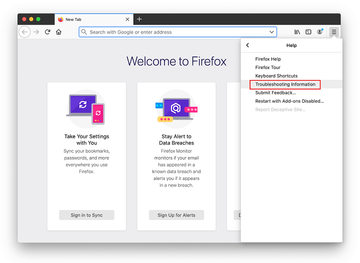
- When on the Troubleshooting Information screen, click on the Refresh Firefox button.
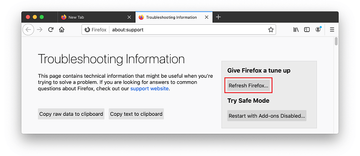
- Confirm the intended changes and restart Firefox.
- Open Firefox and go to Help – Troubleshooting Information (or type about:support in the URL bar and press Enter).
Get rid of Onclickbright virus using Combo Cleaner removal tool
The Mac maintenance and security app called Combo Cleaner is a one-stop tool to detect and remove Onclickbright virus. This technique has substantial benefits over manual cleanup, because the utility gets hourly virus definition updates and can accurately spot even the newest Mac infections.
Furthermore, the automatic solution will find the core files of the malware deep down the system structure, which might otherwise be a challenge to locate. Here’s a walkthrough to sort out the Onclickbright issue using Combo Cleaner:
Download Combo Cleaner installer. When done, double-click the combocleaner.dmg file and follow the prompts to install the tool onto your Mac.
By downloading any applications recommended on this website you agree to our Terms and Conditions and Privacy Policy. The free scanner checks whether your Mac is infected. To get rid of malware, you need to purchase the Premium version of Combo Cleaner.
Open the app from your Launchpad and let it run an update of the malware signature database to make sure it can identify the latest threats.
Click the Start Combo Scan button to check your Mac for malicious activity as well as performance issues.

Examine the scan results. If the report says “No Threats”, then you are on the right track with the manual cleaning and can safely proceed to tidy up the web browser that may continue to act up due to the after-effects of the malware attack (see instructions above).
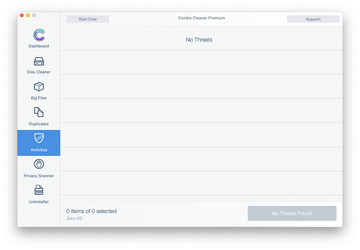
In case Combo Cleaner has detected malicious code, click the Remove Selected Items button and have the utility remove Onclickbright threat along with any other viruses, PUPs (potentially unwanted programs), or junk files that don’t belong on your Mac.
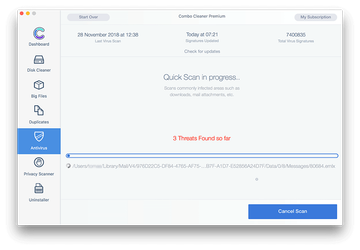
Once you have made doubly sure that the malicious app is uninstalled, the browser-level troubleshooting might still be on your to-do list. If your preferred browser is affected, resort to the previous section of this tutorial to revert to hassle-free web surfing.
